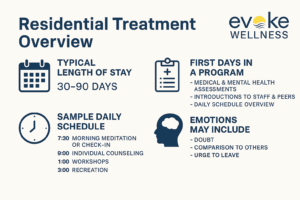If you’ve stepped away from care before—or you’re wondering if it’s worth trying again—it’s normal to feel a mix of hope and hesitation. You might be replaying the last time you were in treatment, remembering what was hard, or wondering if you’ll just end up leaving again. Those thoughts are human.
A residential treatment program offers something unique: a place where daily life is designed around your healing. No work deadlines. No friends who “don’t get it.” No pressure to juggle recovery with the noise of everyday life. Just time, space, and support to focus on one thing—getting well.
Understanding what happens there, how long you might stay, and what the days are really like can make the idea of returning feel less like a leap into the unknown and more like a step you can actually take.
Step 1: Understand the Typical Length of Stay
Most residential treatment programs last between 30 and 90 days, but this isn’t a hard rule. Some people benefit from shorter stays, while others need more time. Think of it like physical rehab after an injury—you don’t leave the moment you can stand. You leave when your body is stable enough to keep improving at home.
Your length of stay will depend on:
- Your unique needs – medical, emotional, and practical
- Progress in treatment – how you’re responding to therapy and structure
- Post-treatment plans – whether you’ll have strong outpatient or community support
If you’ve left treatment early before, you might feel like you “missed your shot.” You haven’t. Sometimes the first try helps you get familiar with the environment so that when you return, you can engage more fully. Many people actually find their second or third time in treatment more impactful because they already know what to expect.
Step 2: Know What Your First Days Will Look Like
The first few days in a residential program are about grounding you. You’ll meet your care team, go through an orientation, and start settling into a routine.
This often includes:
- Medical and mental health assessments – to understand your current needs
- Introductions to staff and peers – to help you feel less like “the new person”
- Tour of the facility – so you know where to go and what’s available
- Daily schedule overview – so you can mentally prepare for the rhythm of the day
If you’ve been through an intake before, you might be tempted to skip over it in your mind. But this step is important—it helps the team understand you as you are today, not as you were the last time you were in care.
Step 3: See How the Daily Schedule Supports Recovery
Residential treatment programs work because they replace chaos with structure. That doesn’t mean every minute is “therapy” or “work.” A healthy balance of learning, rest, and personal time helps you rebuild stability.
A typical day might look like this:
- 7:30 AM – Morning meditation or check-in: Helps set your mindset for the day.
- 8:00 AM – Breakfast: Shared meals encourage connection.
- 9:00 AM – Individual counseling: Focused time with your therapist.
- 10:00 AM – Group therapy: Learning from others and sharing your own experiences.
- 12:00 PM – Lunch: Another chance for community bonding.
- 1:00 PM – Skills or educational workshops: Topics like relapse prevention, stress management, or nutrition.
- 3:00 PM – Physical or recreational activity: Light exercise, art therapy, or outdoor time.
- 5:00 PM – Dinner: Often followed by unstructured downtime.
- 7:00 PM – Evening support meeting: Reflecting on the day and preparing for tomorrow.
This rhythm builds habits that you can take with you after you leave—something that’s harder to do in an outpatient setting if your life outside is still unpredictable.

Step 4: Expect Emotional Ups and Downs
Even in the most supportive environment, recovery isn’t a straight line. You might have moments of doubt. You might compare yourself to others. You might think about leaving.
These feelings don’t mean you’re doing it wrong—they mean you’re human. And in residential care, you have immediate access to therapists, peers, and staff who can help you move through those moments without giving up.
One client once described it this way: “In outpatient, I could disappear when I had a bad day. In residential, I had people knocking on my door—not to scold me, but to sit with me until I felt steady again.”
Step 5: See the Bigger Goal Beyond Discharge
Leaving residential treatment isn’t the end of your recovery—it’s the start of a new phase. A strong program will help you prepare for life after discharge so you’re not stepping into it unprepared.
This can include:
- Aftercare planning – scheduling outpatient therapy or IOP
- Connecting you with community support – like 12-step meetings or peer recovery groups
- Relapse prevention strategies – practical tools for real-life triggers
- Family sessions – helping loved ones understand how to support you
If you’ve left treatment before and relapsed, it doesn’t erase what you learned. Many people return to care with a sharper understanding of what they need to work on—and that can make the next phase stronger.
Step 6: Remember, You Can Always Return
One of the most important truths about treatment: the door is always open. You might think leaving early burned a bridge, but in most reputable programs, that’s not the case. Staff know recovery is rarely a perfect, uninterrupted path.
Coming back after a pause isn’t starting over—it’s picking up where you left off, with more insight about what tripped you up before. Every return is a chance to strengthen your foundation.
Call (866)430-9267 or to learn more about our services visit our residential treatment program in Hilliard, Ohio page. Our team is here to help you take the next step—whether it’s your first time in treatment or a return after a break.
Frequently Asked Questions About Residential Treatment
How do I know if residential treatment is right for me?
If outpatient care hasn’t been enough to keep you stable, or if your home environment makes recovery difficult, residential care can provide the 24/7 structure and support you need.
What should I pack for a residential stay?
Most programs provide a packing list. Essentials often include comfortable clothing, toiletries, a journal, and any approved medications. Avoid bringing items that could disrupt your focus, like alcohol, drugs, or electronics not allowed by the program.
Can I contact my family while in residential treatment?
Yes, but programs often have guidelines to help you focus on recovery in the early days. Some limit phone calls at first, then allow scheduled times for contact.
What if I leave early again?
While it’s best to complete the program, leaving early doesn’t make you a failure. You can always return, and the staff will work with you to understand what made it hard to stay last time.
How much does residential treatment cost?
Costs vary depending on program length, amenities, and insurance coverage. Most centers, including Evoke Wellness Ohio, can verify your benefits and discuss payment options before you commit.
Will I have free time?
Yes. While the days are structured, there’s time for rest, reading, journaling, or hobbies. Balance is part of the healing process.



